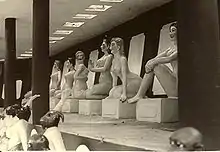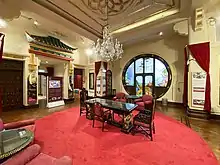| Haw Par Mansion | |
|---|---|
| 虎豹別墅 | |
 1953 picture of the Tiger Pagoda and Haw Par Mansion. | |
| Location | 15 Tai Hang Road, Tai Hang, Wan Chai, Hong Kong |
| Area | 3.2 hectares (32,000 m2) |
| Opened | 1950s |
| Founder | Aw Boon Haw |
| Designation | |
| Designated | 18 December 2009 |
| Tiger Balm Garden | |||||||||
|---|---|---|---|---|---|---|---|---|---|
| Traditional Chinese | 虎豹別墅 | ||||||||
| |||||||||
| Tiger Balm Garden | |||||||||
| Traditional Chinese | 萬金油花園 | ||||||||
| |||||||||
| Aw Boon Haw Garden | |||||||||
| Traditional Chinese | 胡文虎花園 | ||||||||
| |||||||||
Haw Par Mansion, better known for its public gardens known as Tiger Balm Garden or Aw Boon Haw Garden, was a mansion and gardens located at 15, Tai Hang Road, Tai Hang, Wan Chai District, Hong Kong. The Tiger Balm Garden was demolished for redevelopment[1] in 2004.[2] The Haw Par Mansion and its private garden have been preserved.[3]
The Hong Kong Haw Par Mansion and its formerly adjoining Tiger Balm Garden were one of three Tiger Balm mansions and gardens. The others are located in Singapore (now the Haw Par Villa) and in Fujian province, where the gardens remain.[2]
History

The landscaped garden was built at a cost of HK$16 million by Aw Boon Haw and his family in 1935.[4] It was opened to the public in the early 1950s.[5]
In 1961, Aw It Haw (Chinese: 胡一虎), fourth son of late Aw Boon Haw, made an open invitation to the public to buy the land, claiming the land was owned by a family-owned company Haw Par Brothers (Private) Limited (Chinese: 虎豹兄有限公司) chaired by Aw Cheng Chye, son of late Aw Boon Par, which Aw It Haw also claimed that he was authorized by Aw Cheng Chye to published the advertisement of that invitation.[6] However, the head of the flagship business of the late Aw Boon Haw in Hong Kong, Sin Poh Amalgamated (H.K.) Limited, the publisher of Sing Tao Daily, was Aw It Haw's half sister Sally Aw. The lawsuit of the heritage of Aw Boon Haw was settled in 1967.[7]
In 1978 it was reported that Cheung Kong Holdings was interested to redevelop the area.[8] The purchase price was a reported HK$25 million.[9] Cheung Kong Holdings also purchased the contractual rights that Haw Par Brothers (Private) leasing the land to Haw Par Brothers International for 20 years in 1969 (i.e. 10 year remaining in 1979) for a reported HK$40 million.[10][11] Cheung Kong Holdings built Ronsdale Garden on the land lease known as Inland Lot No. 5710. It was reported Sally Aw had bought back part of the Tiger Balm Garden and the mansion in 1984,[12] which was known as Inland Lot No. 8972.
In 1985, the garden was converted into the "Haw Par Villa" amusement park. Many of the sculptures were replaced by rides at that time, and were later replaced again by the old statues.[2]
In 1998 the heir to the property, Sally Aw, sold the entire Garden complex to the land development company Cheung Kong (via Metrofond Limited) for redevelopment.[2][13] In 2001, The Hong Kong Government reached an agreement with Cheung Kong that, as part of the land premium payment, the Hong Kong Antiquities and Monuments Office (AMO) was responsible to preserve and restore the Haw Par Mansion itself together with its private garden as a museum.[14] Cheung Kong only paid HK$943 million as land premium to the government to change the terms in the land lease for redevelopment[15] due to the surrender of the mansion to the government.
When the Tiger Balm Garden was demolished for redevelopment[1] in 2004, many of the garden's murals and statues were salvaged by the AMO.[2] The site of the Garden is now occupied by the residential development The Legend at Jardine's Lookout.[2] Occupancy of the residence started in the first quarter of 2007.[16]
Features
The original gardens covered eight acres (3.2 ha).[1] A seven-storey Tiger Pagoda was the highlight of the garden. Other tourist attractions included artificial Chinese landscaping dotted with sculptures.
Haw Par Mansion


The three-storey Haw Par Mansion was the Aw family's residence in Hong Kong. It was built in 1935 in the Chinese Renaissance style.[3] There are more than 500 relics in the Mansion; they underwent restoration and repair.[17] The building became a Grade II historic building[18] in 2000[3] and was granted Grade I status on 18 December 2009.[19]
See also
- Haw Par Villa, Singapore
References
- 1 2 3 Hong Kong Island West Drainage Tunnel. Impact on cultural heritage. January 2006
- 1 2 3 4 5 6 Doug Meigs, "Balmy days of Tiger Balm heritage", China Daily eClips, Nov 11 2010
- 1 2 3 Brief Information on Proposed Grade I Items. Item #94
- ↑ orientalarchitecture.com "Tiger Balm Gardens (1935)"
- ↑ Theobald, William F. (14 June 2012). Global Tourism. Routledge. ISBN 978-1-136-40052-0.
- ↑ 新聞人物胡一虎接見記者. Ta Kung Pao (in Chinese). Hong Kong. 24 October 1961. p. 6 – via Hong Kong Public Libraries.
- ↑ Written at Hong Kong. "Aw family dispute is settled for [S]$1.7 m". The Straits Times. Singapore. 9 May 1967. Retrieved 9 October 2017 – via Singapore National Library.
- ↑ "傳虎豹別墅再發展改建高尚住宅區". The Kung Sheung Evening News. Hong Kong. 15 March 1978. p. 2 – via Hong Kong Public Libraries.
- ↑ "虎豹別墅拆卸". The Kung Sheung Daily News. Hong Kong. 16 March 1978. p. 6 – via Hong Kong Public Libraries.
- ↑ Written at Singapore. "虎豹別墅售與長實附屬公司". The Kung Sheung Evening News. Hong Kong. Agence France-Presse. 29 November 1979 [Written on 28 November 1979]. p. 6 – via Hong Kong Public Libraries.
- ↑ "[S]$17.4m sale by Haw Par". New Nation. Singapore. 29 November 1979. Retrieved 9 October 2017 – via Singapore National Library.
- ↑ "NewspaperSG - Terms and Conditions" 香港虎豹别墅重归胡仙. Lianhe Wanbao (in Chinese). Singapore News and Publications. 5 June 1984. Retrieved 9 October 2017 – via Singapore National Library.
- ↑ Leung, Ambrose; Lai, Chloe (2 May 2007). "Nobody wants the Haw Par Mansion". South China Morning Post. Retrieved 6 December 2015.
- ↑ Antiquities and Monuments Office.2004(DEC).Heritage Hong Kong(14)
- ↑ http://www.landsd.gov.hk/en/exc_mod/exc/exc2001e.pdf
- ↑ thaiworldview.com "Tiger Balm Garden"
- ↑ Antiquities and Monument Office. 2006. Heritage Hong Kong(16).
- ↑ "List of Graded Historic Buildings in Hong Kong (as at 6 November 2009)" (PDF). Archived from the original (PDF) on 9 July 2011. (387 KB)
- ↑ List of the Historic Buildings in Building Assessment (as of 25 January 2011) Archived 22 September 2013 at the Wayback Machine
External links
![]() Media related to Tiger Balm Garden (Hong Kong) at Wikimedia Commons
Media related to Tiger Balm Garden (Hong Kong) at Wikimedia Commons
![]() Media related to Haw Par Mansion at Wikimedia Commons
Media related to Haw Par Mansion at Wikimedia Commons
- Webpage with pictures of Haw Par Mansion (in Chinese)
- Videos of Tiger Balm Garden:
- press release: "Haw Par Mansion to hold open days", HK Government, 21 October 2010
- press release: "Invitation of tenders for conservation and revitalisation of Haw Par Mansion", HK Government. 28 January 2011
- Plan showing the location of Haw Par Mansion, February 2004
- Picture of Haw Par Mansion
- The Role of an Estate Surveyor in Preserving Heritage – Haw Par Mansion, Tai Hang Archived 21 July 2011 at the Wayback Machine
- Tender invitation for the revitalisation of the Haw Par Mansion Archived 20 July 2011 at the Wayback Machine